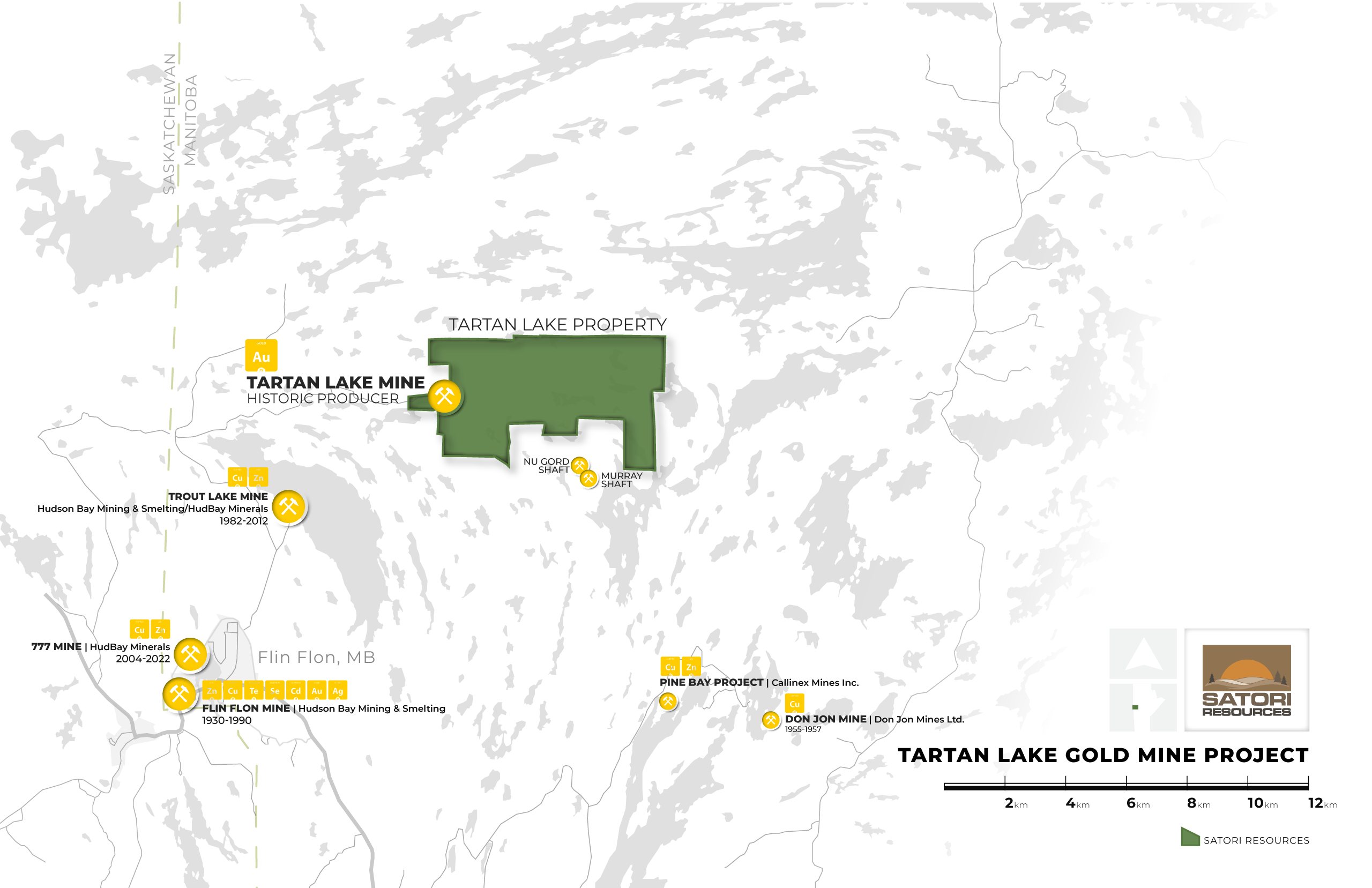OVERVIEW
Canadian Gold Corp. holds a 100% interest (subject to an NSR) in the Tartan Lake Gold Mine Project, which produced 47,000 ounces of gold between 1987 and 1989. The property covers approximately 2,670 hectares and consists of 20 mineral claims. The Project includes a 450 mt/day processing plant, related surface infrastructure, and a decline providing access to developed mining blocks within the Main and South Zones to a vertical depth of 320 metres from surface. The property is road-accessible from the nearby mining town of Flin Flon and is hydro connected.
Current mineral resources are estimated to be:
Indicated 1,180,000 tonnes @ 6.32 g/t Au (240,000 oz Au)
Inferred 240,000 tonnes @ 4.89 g/t Au (37,000 oz Au).
Mineral resources are estimated above a 3.0 g/t Au cut-off grade.
The mineral resource was estimated by S. Butler P.Geo., A. Armitage P.Geol., P. Karelse P.Geo., and A. Petrovic P.Eng., of Mining Plus Canada Consulting Ltd., a company independent of Canadian Gold Corp. (formerly Canadian Gold Corp Resources Inc.) The Technical Report titled; “Canadian Gold Corp Resources Tartan Lake Project Technical Report Manitoba, Canada April 2017” with an effective date of April 5 2017, discloses the key assumptions, methodology and observations related to the estimate. The report is available on SEDAR+ and the link below.
MOVING IN THE RIGHT DIRECTION
In 1989, the operator of the Tartan Lake Gold Mine Project faced the challenges of unsuitable mining and milling equipment, together with a collapsed gold price of under US$400 per ounce. Over the ensuing decades, subsequent owners had either allocated resources to other in-house projects, or carried out sporadic, under-capitalized programs due to the then bear markets.
With a new team in place, improved access to capital, and a past producing gold project with road access, grid power to site, an existing resource, significant underground development, 15 historical geophysical targets delineated outside of the deposit area, the new team at Canadian Gold Corp, which includes Wes Hanson, the former chief underground geologist at Tartan Lake in the 80’s when the mine produced, completed 7,295 metres of diamond drilling, which: (i) returned some of the highest grade intercepts in the project’s history; (ii) successfully expanded the resource footprint at both the Main and South Zones approximately 200 metres down plunge; and (iii) uncovered an interpreted new zone of mineralization sub-parallel to the Main Zone.
Other highlights include:
- Second highest grade interval ever reported at Tartan Lake Main Zone – TLMZ21-12 returning 23.76 Au g/t over 12.60 metres, and including 47.56 Au g/t over 5.80 metres.
- Longest and highest grade interval ever reported at Tartan Lake South Zone – TLSZ21-05 returning 9.59 g/t Au over 11.75 metres, including 24.23 g/t Au over 2.00 metres and 13.05 g/t Au over 3.29 metres.
- High grade mineralization intercepted at a 200 metre step out, down plunge of previously drilled holes at Main Zone.
- Interpreted new zone of mineralization in the hanging wall zone situated sub-parallel to the Main Zone was not observed in earlier holes, and intersected 20-25 metres above the quartz-carbonate-tourmaline veins defining the Main Zone.
- Unusually low water levels at the Sly Fox showing three kilometres east of the mine site area exposed significant outcrop along the shoreline of Batters Lake, exposing extensive zones of shearing similar to that at the Main and South Zones.
- Geophysical anomalies were associated with regional scale folding along a northeast axis mapped at the Sly Fox area during the October, 2021 ground reconnaissance program, providing a compelling prospective target area for 2022.
- A historically stripped (30 x 50 metres) area within an extensive regional shear zone at McFadden, where 20 historical channel samples were collected – some reporting highly anomalous results, contains extensive quartz-carbonate-tourmaline veining over several metres in width, similar to those observed at the Main and South Zone deposits.
HISTORIC GOLD PRODUCTION IN MANITOBA
In 1985, Granges Exploration Ltd. (Granges) estimated a pre-mining, proven and probable mineral reserve of of 620,000 tonnes averaging 8.5 g/t Au (160,000 ozs Au). Canadian Gold Corp advises that this estimate is historical, is disclosed solely for context and should not be relied upon.
In 1986, Granges and their joint venture partner, Abermin Corporation, commenced construction of the Tartan Lake Mine, establishing all season road access and a permanent connection to the Manitoba power grid along a 21 kilometer corridor from Flin Flon Mb. A 250 tonne per day mill, mechanical shop, warehouse and offices were constructed. An underground decline with a 4.3 x 4.5 meter cross sectional profile was collared and completed to the 150 meter level. The decline was eventually extended to the 300 meter level. Commercial production commenced in early 1987. The mill facility was upgraded in 1988 to a nominal 500 tonne per day throughput rate. From 1987 through 1989, the mine produced 36,000 ounces of gold from 250,000 tonnes of ore. Life of mine metallurgical recovery was estimated to be 76% suggesting an average feed grade of 5.8 g/tonne Au. Production ceased in 1989 due to failing gold prices and the mine was placed under care and maintenance.
GEOLOGY
Tartan Lake is located within the world class Flin Flon greenstone belt (FFGB), an easterly trending, Lower Proterozoic volcanic arc complex. The rocks of the FFGB can be divided into two main groups; metavolcanic and metasedimentary rocks of the Flin Flon assemblage (Amisk Group) and metaconglomerates, metasandstones and greywackes of the Missi Formation which uncomformably overlie the Flin Flon assemblage. Four major phases of deformation have been identified, all of which have contributed to the development of the major structures hosting anomalous gold mineralization at Tartan Lake.
The Tartan Lake Project area is dominated by a strong east-west striking shear zone complex that can be traced for over 10 kilometers across the entire claim group. At the mine, the shear zone defines the contact between footwall intrusive rocks to the south and the hanging wall rocks of Flin Flon assemblage to the north. The shear zone varies between 30 to 50 meters in width, dips steeply to the north and trends east west. Multiple, sub-parallel, anastomosing quartz carbonate veins occur within the shear zone. Gold is associated with these quartz veins. The Tartan Lake deposits are interpreted to be greenstone hosted quartz carbonate vein deposits. Typically, these gold bearing quartz carbonate veins can extend for several kilometers in depth.

